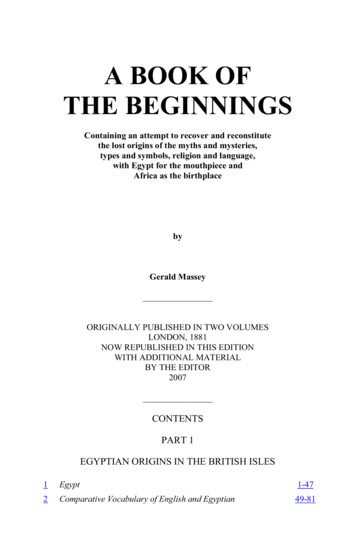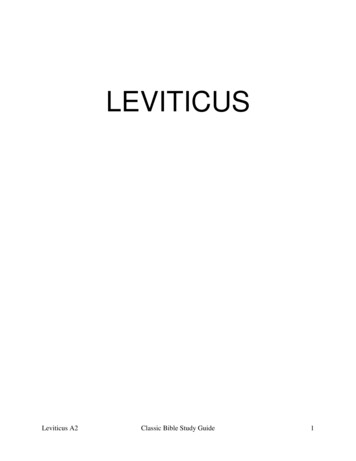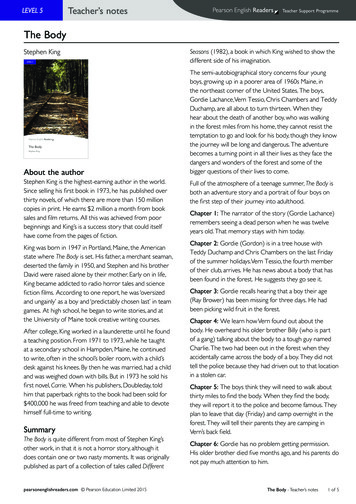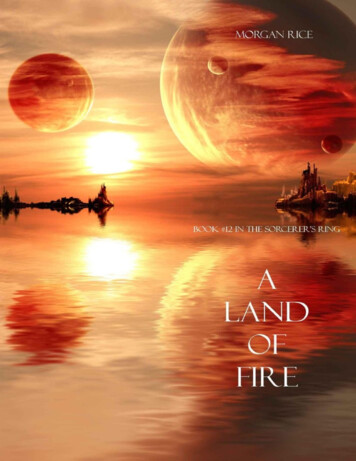
Transcription
A BOOK OFTHE BEGINNINGSContaining an attempt to recover and reconstitutethe lost origins of the myths and mysteries,types and symbols, religion and language,with Egypt for the mouthpiece andAfrica as the birthplacebyGerald MasseyORIGINALLY PUBLISHED IN TWO VOLUMESLONDON, 1881NOW REPUBLISHED IN THIS EDITIONWITH ADDITIONAL MATERIALBY THE EDITOR2007CONTENTSPART 1EGYPTIAN ORIGINS IN THE BRITISH ISLES1Egypt1-472Comparative Vocabulary of English and Egyptian49-81
345678910Hieroglyphics in Britain83-134Egyptian Origins in Words135179Egyptian Water-Names180207Egyptian Names of Personages208248British Symbolical Customs and Egyptian Naming249310Egyptian Deities in the British Isles311369Egyptian Place-Names and the Record of the Stones370443Type-Names of the People444503PART 2EGYPTIAN ORIGINS IN THE HEBREW,AKKADO-ASSYRIAN AND MAORI11Comparative Vocabulary of Hebrew and Egyptian Words1-2112Hebrew Cruxes with Egyptian Illustrations23-7913Egyptian Origins in the Hebrew Scriptures, Religion, Languages80-124and Letters141516171819The Phenomenal Origins of Jehovah-ElohimThe Exodus125173174175Egyptian Origin of the Exodus176227Moses and Joshua, of the Two Lion-Gods of Egypt228280An Egyptian Dynasty of Hebrew Deities Identified from theMonuments281362The Egyptian Origin of the Jews traced from the Monuments363441Comparative Vocabulary of Akkado-Assyrian and EgyptianWords443456
2021222312Egyptian Origins in the Akkado-Assyrian Language andMythology457521Comparative Vocabulary of Maori and Egyptian WordsA Quote by Max Muller523533534African Origins of the Maori535598Roots in Africa Beyond Egypt599674Notes to Part 1Notes to Part 2675682683684ILLUSTRATIONSZodiac from the centre of the ceiling of DenderahLarger View
Egyptian zodiac assigned to the second Hermes, according to KircherLarger View
EGYPTEgypt! how have I dwelt with you in dreams,So long, so intimately, that it seemsAs if you had borne me; though I could not knowIt was so many thousand years ago!And in my gropings darkly undergroundThe long-lost memory at last is foundOf motherhoodʊyou Mother of us all!And to my fellowmen I must recallThe memory too; that common motherhoodMay help to make the common brotherhood.Egypt! it lies there in the far-off past,Opening with depths profound and growths as vastAs the great valley of Yosemité;The birthplace out of darkness into day;The shaping matrix of the human mind;The cradle and nursery of our kind.This was the land created from the flood,The land of Atum, made of the red mud,Where Num sat in his Teba throned on high,And saw the deluge once a year go by,Each brimming with the blessing that is brought,And by that waterway, in Egypt's thought,The gods descended; but they never hurledThe Deluge that should desolate the world.There the vast hewers of the the early timeBuilt, as if that way they would surely climbThe Heavens, and left their labours without nameʊColossal as their carelessness of fameʊSole likeness of themselvesʊthat heavenwardFor ever look with statuesque regard,As if some vision of the Eternal grownPetrific, was forever fixed in stone!They watched the Moon re-orb, the Stars go round,And drew the Circle; Thought's primordial bound.The Heavens looked into them with living eyesTo kindle starry thoughts in other skies,For us reflected in the image-scroll,That might by night the stars for aye unroll.The Royal Heads of Language bow them downTo lay in Egypt's lap each borrowed crown.The glory of Greece was but the AfterglowOf her forgotten greatness lying low;Her Hieroglyphics buried dark as night,Or coal-deposits filled with future light,
Are mines of meaning; by their light we seeThro' many an overshadowing mystery.The nursing Nile is living Egypt still,And as her lowlands with its freshness fill,And heave with double-breasted bounteousness,So doth the old Hidden Source of mind blessThe nations; secretly she brought to birth,And Egypt still enriches all the earth.MOTHER SHIPTON'S PROPHECY OFTHE 'END OF THE WORLD'IN THE YEAR 1881Some relics of the ancient Circle-Craft are still extant in Britain, and we have ourmisinterpreted prophecies in common with the Hebrew (see Pt. 2, pp.388-98). Accordingto one of these the World is to end in the year 1881.The 'end of the world' is the end of an aeon, age or cycle of Time, and we have seen theprophecy fulfilled in the rare lunar and planetary conjunction which occurred on the 3rdof March. It now remains for scientific astronomy to determine the length of thisparticular cycle of Time and define its relationship to the period of precession.The ending of an Old World (or Aeon) and commencement of a New is an appropriatedate for the birth of A Book of the Beginnings.March 4th, 1881BACKHOMEThis page last updated:CONTACTNEXT
[p.1]A BOOK OF THE BEGINNINGSSECTION 1EGYPTTravellers who have climbed and stood upon the summit of the Great Pyramid of Gizatell us how all that is most characteristic of Egypt is then and there in sight. To the southis the long necropolis of the desert, whose chief monuments are the pyramids of Abusir,Dashur, and Saqqara. That way lies the granite mountain flood-gate of the waters, whichcome winding along from the home of the hippopotami to leap down into the Nile-valleyat last with a roar and a rush for the Mediterranean Sea. To the north there is desert also,pointed out by the ruined pyramid of Aburuash. To the west are the Libyan Hills and alimitless stretch of yellow sand. Again, there is a grey desert beyond the white line ofCairo, under the Mukattam Hills.And through these sandy stony desert borders, Egypt runs alongside of its river in adouble line of living green, the northward flowing waters and their meadowy marginbroadening beneficently into the Delta. Underfoot is the Great Pyramid, still aninscrutable image of might and of mystery, strewn round with reliquary rubbish thatevery whirl of wind turns over as leaves in a book, revealing strange readings of the past;every chip and shard of the fragments not yet ground down to dusty nothing may possiblyhave their secret to tell[1].The Great Pyramid is built at the northern end of the valley where it relatively overtopsthe first cataract, nearly 600 miles away to the south, and, as the eye of the whole picture,loftily [p.2] looks down on every part of the whole cultivated land of Egypt. It is builtwhere the land comes to an apex like the shape of the pyramid itself lying flat andpointing south, and the alluvial soil of the Delta spreads out fanwise to the north. It isnear to the centre of the land-surface of the globe. A Hermean fragment shows the earthfigured as a woman in a recumbent position with arms uplifted towards heaven, and feetraised in the direction of the Great Bear. The geographical divisions are represented byher body, and Egypt is typified as the heart of all[2]. They set the base of the GreatPyramid very near the heart of all, or about one mile 568 yards south of the thirtiethparallel of latitude[3].
There, in the stainless air, under the rainless azure, all is so clear that distance cannot bemeasured, and the remotest past stands up close to you, distinct in its monumental formsand features as it was thousands of years ago; the colour yet unfaded from its face, forevery influence of nature (save man) has conspired to preserve the works of art, and makedead Egypt as it were the embalmed body of an early time eternized.Once a year the deluge comes down from above, flowing from the lakes lying far away,large as inland seas, and transforms the dry land into a garden, making the sandy waste toblossom and bear the 'double-breasted bounteousness' of two harvests a year, with thisnew tide of life from the heart of Africa. Not only does the wilderness flush with colour,for the waters, which had been running of a dull green hue, are suddenly troubled andturned crimson. The red oxide of iron mixes with the liquid and gives it a gory gleam inthe sunlight, making it run like a river of blood.There is an antithesis to the inundation in another phenomenon almost as unique. This isfound in the steady continuance of the north wind that blows back the waters and spreadstheir wealth over a larger surface of soil, and enables the boatman to sail up the river rightagainst the descending current. Everything Egyptian is typical, and when we see how thepeople figured the Two Truths of mythology as the two factors of being, and how theypersonified breath and water, we shall more or less perceive the initiatory import of thiswonderful arrangement of wind and tide, and its combination of descending andascending motive power.The Nile water is highly charged with ammonia and organic matter, which are depositedas manure. It is, for instance, three times as rich in fertilising matter, whether insuspension or in solution, as the Thames at Hampton Court.The Great Mendes Stele says:—'The entire wealth of the soil rests on the inundation of the Nile that brings itsproducts.'[4]This bounty was spread out for all by [p.3] the breath of the beneficent wind. Num, Lordof the Inundation, is painted on the monument as the Green God, and the limit of theinundation was the measure of Egypt's greenness. The waters that brought the silt clothedthe soil with that colour just so far as they were blown.From the beginning Lower Egypt, the Delta, was a land literally rained down by theinundation as a gift of the gods. For the clouds arise from their several seas and sail offheavily-laden toward equatorial Africa, and there pour forth their weight of water duringa rain of months on mountain slopes that drain into the fresh lakes until these arebrimmed to bursting, and their northern outlet of birth is the Nile. The White Nile at first,until the Abyssinian highlands pour into it their rushing rivers of collected rain with forceenough to float a mass of silt that is part of a future soil, the presence of which in thewaters makes the Blue Nile; then the river becomes the turbid Red Nile of the inundation,and as it spreads out fan-wise towards the Mediterranean Sea, it drops that rich top-
dressing. of soil or the very fat of land and unctuous mud-manure, every year renewedand rained down by that phenomenal flood. We shall find the whole of the deluge legendsof the world, and all the symbolical deluge language used in astronomical reckoning, arebound up inseparably with this fact of the inundation of Egypt. The universal mythicalbeginning with the waters, the genesis of creation and of man from the mud, are offspringof this birthplace and parentage. In no other part of earth under heaven can there be foundthe scenery of the inundation visibly creating the earth, as it is still extant in the land ofmarvel and mystery. Only in Egypt could such a phenomenon be observed as the periodicoverflow of the river Nile, that not only fertilises the fields with its annual flood, butactually deposits the earth, and visibly realises that imagery of the mythicalcommencement of all creation, the beginning with the waters and the mud, preserved inso many of the myths.According to Aulus Gellius[5], Egypt was named Aeria. The Egyptian Aur (later Aer) isthe name of the river Hebrew Iar. Aeria is the land of the river, possibly with the furthermeaning of the pure, as ia means to wash, whiten, purify. Another name of Egypt isTameri. Ta is to drop, heap, deposit, type; meri is the inundation, Tameri is land thusdeposited. The vulgar English to ta is a child's word, and it means to deposit soil; also Tameri reads the gift of the inundation, the gift of the goddess Meri who has a dual form asMeri-Res (South) and Meri-Mehi (North). Egypt is also designated the Land of theEye[6]. The eye of the cow shedding an emblematic tear was a type of ta-ing.It is also called Khemi, the land of the gum-tree, and the acacia [p.4] gum-tree suppliedanother symbol of shedding substance; or, of the kamai-plant, from which the Egyptiansobtained a precious oil.Khemi, Egypt, is personified as a female who wears on her head a sign which Wilkinsonthought indicated 'cultivated land,'[7] but it means the land created from the waters,determined by the sign of marshland or land recovered from the waters. The sign is thedeterminative of hat, chaos, or precommencement, and its true value may be found in theCornish hatch, a dam.Egypt is often called Kam, the Black Land, and kam does signify black; the nameprobably applied to the earliest inhabitants whose type is the kam or ham of the Hebrewwriters. But kam is likewise to create, and this was the created land; visibly created likethe gum from the tree by droppings. Kam is the root and has the value of the wordchemistry, and the land of Kam was the result of Nature's chemistry, aided by the hatchesor dams.The Assyrians called Egypt Muzr. Muzau is source, an issue of water, a gathering orcollecting. It is the Egyptian mes, the product of a river. Now it is important for thepresent purpose to wring the meaning out of Egyptian words, drop by drop, every one isportentous and symbolical. For example, mes means mass, cake, chaos, it is the productof the waters gathered, engendered, massed. The sign of this mass was the hieroglyphiccake, the Egyptian ideograph of land (Û)[8]. This cake of mesi was figured and eaten astheir bread of the mass, a seed-cake too as the hieroglyphics reveal. And the cake is
extant today in the wafer still called by the name of the Mass, as it was in Egypt. Mes, theproduct of the waters and the cake, is likewise the name for chaos, the chaos of allmythological beginning. Mes, then, the mass or product of the river when caked, is theprimeval land, the pure land periodically produced from the waters, the land of Mesr,whether of black mud or red.We find a word in Ethiopic similar to metzr meaning the earth, land, soil. Mazr, or mizr,is an Arabic name of red mud. There is, however, a mystical reason for this red applied tomud as a synonym of source or beginning.These derivations of the names from Kam, the created land; mes, the product of the river;tameri, the soil and gift of the inundation, show that Lower Egypt was designated fromthe soil that was shed, dropped, wept, deposited by the inundation of the Nile, and thatthe natives were in various ways calling it the Alluvial Land.But the Hebrew name of Egypt, Mitzraim, applies to both lands. For this we have to gofarther than Lower Egypt, and mes, the product of a river, the mud of mythology.We may rest assured, says Brugsch-Bey, that at the basis of the designations Muzur(Assyrian), Mizr (Arabic), Mitzraim (Hebrew), there lies an original form consisting ofthe three letters m r s, all [p.5] explanations of which have as yet been unsuccessful[9].His rendering of the meaning as Mazor, the fortified land, the present writer considers themost unsuccessful of all. Mest-ru and Mest-ur are the Egyptian equivalents for theHebrew Mitzr, plural Mitzraim, and the word enters into the name of the MestraeanPrinces of the Old Egyptian Chronicle[10]. Mest (Eg.) is the birthplace, literally thelying-in chamber, the lair of the whelp; and ru is the gate, door, mouth of outlet; ur is thegreat, oldest, chief. Mest-ru is the outlet from the birthplace. In this sense the pluralMitzraim would denote the double land of the outlet from the inland birthplace.There is a star 'Mizar' in the tail of the Great Bear, the typhonian type of the genetrix andthe birthplace, whose name is that of Lower Egypt or Khebt. Mest (Eg.) is the tail, end,sexual part, the womb, and ur is the great, chief, primordial. Thus Mitzraim and Khebtare identical in the planisphere as a figure of the birthplace, found in Khebt or Mitzraimbelow. Mest-ur yields the chief and most ancient place of birth which is not to be limitedto Lower Egypt.It is certain, however, says Fuerst, that ʮʶʸ and ʮʶʥʸ meant originally and chiefly theinhabitants[11], it is here that mest-ur has the superiority over Mest-ru. The ru in mest-ruadds little to the birthplace, whereas the compound mestur expresses both the eldest bornand the oldest birthplace. The Hebrew ʶ represents a hieroglyphic tes which deposited aphonetic t and s, hence the permutation; mtzr is equated by mstr, and both modify intomisr. In the same way the Hebrew Matzebah (ʮʶʡʤ) renders the Egyptian Mastebah.Also, Mizraim is written Mestraim by Eupolemus. Khum, he says, was the father of theEthiopians, and brother of Mestraim, the father of the Egyptians[12].
The name Egypt, Greek Aiguptos, is found in Egyptian as Khebt, the Kheb, a name ofLower Egypt. Khebt, Khept or Kheft means the lower, the hinder-part, the north, theplace of emanation, the region of the Great Bear. The f, p and b are extant in Kuft, a townof Upper Egypt; in Coptos, that is Khept-her or Khept above, whence came theCaphtorim of the Hebrew writings[13], enumerated among the sons of Mitzraim, andKheb, Lower Egypt.The Samaritan Pentateuch[14] renders Mitzraim by the name of Nephiq ʰʴʩʷ whichdenotes the birth-land (ka) with the sense of issuing forth; Aramaic ʰʴʷ to go out. InEgyptian nefika would indicate the inner land of breath, expulsion, going out, or it mightbe the country of the sailors.The land of Egypt was reborn annually as the product of the waters was added layer bylayer to the soil. Three months inundation and nine months dry made up the year. Thenine months [p.6] coincided with the human period of gestation, a fact most fruitful insuggestion, as everything seems to have designedly been in this birthplace of ideas. Theydated their year from the first quickening heave of the river, coincident with the summersolstice and the heliacal rising of the Dog-star. The Nile not only taught them to look upto the heavens and observe and register there the time and tide of the seasons, but alsohow to deal with the water by means of dykes, locks, canals, and reservoirs, until theirsystem of hydraulics grew a science, their agriculture an art, and they obtained suchmastery over the waters as finally fitted them for issuing forth to conquer the seas andcolonise the world.The waters of Old Nile are a mirror which yet reflects the earliest imagery, made vital bythe mind of man, as the symbols of his thought. A plant growing out of the waters is anideograph of sha (á), a sign and image of primordial cause, and becoming, the substanceborn of, the end of one period and commencement of another, the emblem of rootage inthe water, and breathing in the air, the type of the Two Truths of all Egypt's teaching, thetwo sources of existence ultimately called flesh and spirit, the blood source and breathingsoul.About the time when the Nile began to rise in Lower Egypt, there alighted in the land aremarkable bird of the heron kind which had two long feathers at the back of its head.This, the Ardea purpurea, was named by the Egyptians the bennu, from 'nu,' a periodictype, and 'ben,' splendid, supreme—literally, as the crest indicated, tiptop. It was theirphoenix of the waters, the harbinger of re-arising life, and was adopted as aneschatological type of the resurrection. The planet Venus is called on the monuments the'Star of Bennu Osiris,' that is of Osiris redivivus.The beetle appeared on the Nile banks in the month previous to that of theinundation[15], the month of rebirth, Mesore, and formed its ark against the coming floodto save up and reproduce its seed in due season. This they made their symbol of theCreator by transformation, and type of the only-begotten son of the Father[16].
The inundation supplied them with the typical plough. To plough is to prepare the soil forseed. The inundation was the first preparer of the soil. The inundation is called Mer, andone sign of the Mer is a plough (L). This shows that when they had invented the primitivehand-plough of the hoe kind they named it after the water-plough, or preparer of the soil,and the Mer plough is a symbol of the running water.The river likewise gave them their first lessons in political economy and the benefits ofbarter, by affording the readiest means of exchange. Its direction runs in that of longitude,or meridian, with all the products ranged on either side like stalls in a street; so close tothe [p.7] waterway was the cultivated soil. It crossed through every degree of Egypt'slatitude and became the commercial traveller of the whole land, carrying on their tradefor the enrichment of all.Generally speaking the monuments offer no direct clue to the origin of the people; theybring us face to face with nothing that tells of a beginning or constitutes the bridge overwhich we can pass to look for it in other lands. Like the goddess Neith, Egypt came fromherself, and the fruit she bore was a civilisation, an art, a mythology, a typology,absolutely autochthonous.We see no sign of Egypt in embryo; of its inception, growth, development, birth, nothingis known. It has no visible line of descent, and so far as modern notions go, no offspring;it is without genesis or exodus.When first seen Egypt is old and grey, at the head of a procession of life that is illimitablyvast. It is as if it always had been. There it stands in awful ancientness, like its ownpyramid in the dawn, its sphinx among the sands, or its palm amid the desert.From the first, all is maturity. At an early monumental stage they possess the art ofwriting, a system of hieroglyphics, and the ideographs have passed into the form ofphonetics, which means a space of time unspanable, a stage of advance not taken by theChinese to this day.The monuments testify that a most ancient and original civilisation is there; one thatcannot be traced back on any line of its rootage to any other land. How ancient, none butan Egyptologist who is also an evolutionist dares to dream. At least twelve horizons willhave to be lifted from the modem mind to let in the vistas of Egypt's prehistoric past. Forthis amazing apparition coming out of darkness on the edge of the desert is the head of animmense procession of life—issuing out of a past from which the track has beenobliterated like footprints in the shifting wilderness of sand.The life was lived, and bit by bit deposited the residual result. The tree rooted in thewaste had to grow and lay hold of the earth day by day, year after year, for countlessages. Through the long long night they groped their way, their sole witnesses thewatchers on the starry walls, who have kept their register yet to be read in the astralmyths, for the heavens are Egypt's records of the past.
The immeasurable journey in the desert had to be made, and was made step by stepthrough that immemorial solitude which lies behind it, as certainly as that the river hashad to eat its own way for hundreds of thousands of years through the sandstone, thelimestone, and the granite, in order that it might at last deposit the alluvial riches at theoutlet, even though the stream of Egypt's long life has left no such visible register onearth as the waters of old Nile have engraved in gulf-like hieroglyphics upon the stonytablets of geological time. The might and majesty of Egypt repose upon a [p.8] past asreal as the uplifting rock of the Great Pyramid, and the base, however hidden, must be inproportion to the building.They are there, and that is nearly all that has been said; how or when they got there isunknown. These things are usually spoken of as if the Egyptians had done as we have,found them there. The further we can look back at Egypt the older it grows. Ouracquaintance with it through the Romans and Greeks makes it modern. Also their owngrowth and shedding of the past kept on modernizing the myths, the religion, the types. Itwill often happen that a myth of Egyptian creation may be found in some distant part ofthe world in a form far older than has been retained in Egypt itself.It is a law of evolution that the less developed type is the oldest in structure, reckoningfrom a beginning. This is so with races as with arts. The hieroglyphics are older thanletters, they come next to the living gesture signs that preceded speech. But lessdeveloped stages are found out of Egypt than in it because Egypt went on growing andsloughing off signs of age, whilst the Maori, the Lap, the Papuan, the Fijian sufferedarrest and consequent decadence. And the earlier myth may be recovered by aid of thearrested ruder form.Fortunately the whole world is one wide whispering gallery for Egypt, and her voice maybe heard on the other side of it at times more distinctly than in the place where it wasuttered first. And looking round with faces turned from Egypt we shall find that language,the myths, symbols, and legendary lore of other lands, become a camera obscura for usto behold in part her unrecorded backward past. The mind of universal man is a mirror inwhich Egypt may be seen. We shall find the heavens are telling of her glory. Much of herpre-monumental and pre-monarchical past during which she was governed by the godshas to be reflected for us in these mirrors; the rest must be inferred. Vain is all effort tobuild a boundary wall as her historic starting-point with the debris of mythology.The Stone Age of Egypt is visible in the stone knife continued to be used for the purposeof circumcision, and in the preparation of their mummies. The stone knife was a typepersisting from the time of the stone implements. The workers in bronze, iron, and othermetals did not go back to choose the flint weapon. The 'nuter' sign (Â) of the god is astone axe or adze of the true Celt type.The antiquity of Egypt may be said to have ended long before the classical antiquity ofthe moderns begins, and except in the memorials of myth and language it was premonumental. We know that when Egypt first comes in sight it is old and grey. Among themost ancient of the recipes preserved are prescriptions for dyeing the hair. There are
several recipes for hair dye or washes found in the Ebers Papyrus[17], and one of these isascribed to the lady Skheskh, mother of Teta, the first king on the monuments after Mena.[p.9] This is typical. They were old enough more than 6,000 years ago for leprosy to bethe subject of profound concern. A manuscript of the time of Rameses II says:—'This is the beginning of the collection of receipts for curing leprosy. It was discovered ina very ancient papyrus enclosed in a writing-case under the feet (of a statue) of the godAnubis, in the town of Sakhur, at the time of the reign of his majesty the defunct KingSapti,'[18]who was the fifth pharaoh of the first dynasty, in the list of Abydus.Leprosy was indigenous to Egypt and Africa; it has even been conjectured that the whitenegroes were produced by it, as the albinos of the black race.The most ancient portion known of the ritual, getting on for 7,000 years old, shows thatnot only was the Egyptian mythology founded on the observation of natural phenomenaat that time established, but the mythology had then passed into the final oreschatological phase, and a system of spiritual typology was already evolved from theprimordial matter of mythology. The text of chapter 130 is said in the annotation to havebeen found in the reign of King Housap-ti, who, according to Déveria, was the Usaphaisof Manetho, the fifth king of the first dynasty, and lived over 6,000 years since; at thattime certain parts of the sacred book were discovered as antiquities of which the traditionhad been lost. And this is the chapter of 'vivifying the soul for ever.'[19]The lunar myth with Taht as the word or logos, is at least as old as the monuments (it isindefinitely older), and we know from the Ritual[20] that Sut was the announcer, theword, and represented the Two Truths before the time of Taht; Sut was the first form ofHermes the heaven-born.From almost the remotest monumental times, dated by Bunsen as the seventh centuryafter Mena[21], or according to the present reckoning nearly 4,000 years BC, they hadalready attained to the point of civilisation at which the sacrifice of human beings asofferings to the gods is superseded by that of animals. There is no doubt of the humanvictims once sacrificed, as the sacrificial stamp, with the victim bound and knife at thethroat, still remains to attest the fact[22], as well as the ideographic kher, the humanvictim bound for slaughter (-); kher being one with kill.There is a stone in the museum at Boulaq consecrated to the memory of a noteworthytransaction. We learn from it that in the time of Khufu of the fourth dynasty, and founderof the Great Pyramid, that the sphinx and its recently discovered temple not only existedalready, but were then in a state of dilapidation, and [p.10] it is recorded in the inscriptionthat he restored them. He built the temple of the Great Mother and replaced the divinitiesin her seat.
'The living Har-Sut* King Kufu, giver of life, he founded the house of Isis (Hest)dominating the pyramid near to the house of the sphinx. North-west of the house of Osiristhe Lord of Rostau he built his pyramid near to the temple of that goddess, and near thetemple of his royal daughter Hantsen. He made to his mother Athor, ruling themonument, the value as recorded on the tablet, he gave divine supplies to her, he built hertemple of stone and once more created the divinities in her seat. The temple of the sphinxof Har-Makhu on the south of the house of Isis, ruler of the pyramid, and on the north of(that of) Osiris Lord of Rostau.'[23] This was in a climate where, as Mariette observes,there is no reason why monuments should not last for a hundred thousand years, if leftalone by man[24]. The dilapidation and overthrowal may, to some extent, have been thework of man.* 'Har-Sut.' I read the tie sign in this passage as 'Sut.' The name of Suti is several times written with the tiesign[25].One of the loveliest things in all poetry is in Wordsworth's lines—'And beauty born of murmuring soundShall pass into her face.'[26]Yet this was anticipated by the father of King Pepi of the sixth dynasty in the Praise ofLearning, who says to his son—'Love l
A BOOK OF THE BEGINNINGS Containing an attempt to recover and reconstitute the lost origins of the myths and mysteries, types and symbols, religion and language, with Egypt for the mouthpiece and Africa as the birthplace by Gerald Massey _ ORIGINALLY PUBLISHED IN










